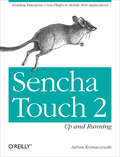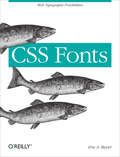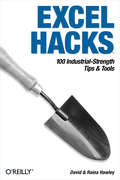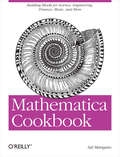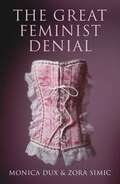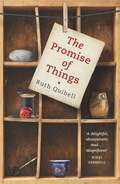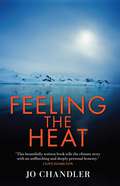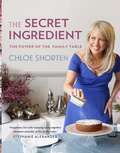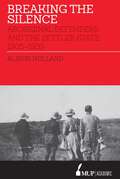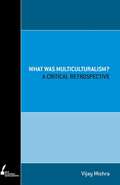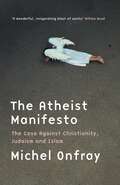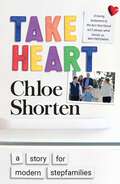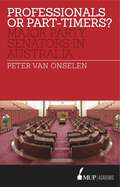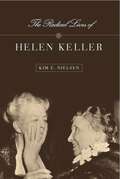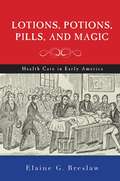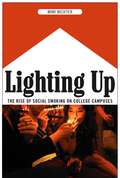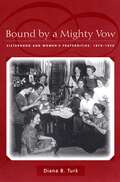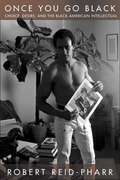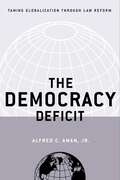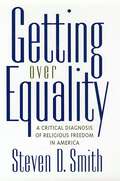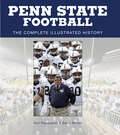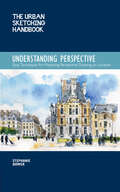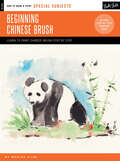- Table View
- List View
Sencha Touch 2 Up and Running: Building Enterprise Cross-Platform Mobile Web Applications
by Adrian KosmaczewskiLaunch into Sencha Touch 2 with this hands-on book, and quickly learn how to develop robust mobile web apps that look and behave like native applications. Using numerous code samples, author Adrian Kosmaczewski guides you every step of the way through this touchscreen-enabled JavaScript framework—from creating your first basic app to debugging, testing, and deploying a finished product. Learn how to craft user interfaces, build forms, and manage data, then deploy as either an HTML5 offline app or as a native app for Android, iOS, or Blackberry.Define classes and create instances with Sencha Touch’s object-oriented abstractionBuild user interfaces with the framework’s extensive set of high-level componentsDevelop apps that consume complex data, whether it’s stored locally or on remote serversOrganize your application code in a consistent, predictable, and maintainable wayUse Sass stylesheets to craft a personalized look and feel for your appDebug, test, and document your app with WebKit Web Inspector, Jasmine, Siesta, and JSDuckUse the Sencha Architect UI designer and IDE to simplify complex project development
CSS Fonts: Web Typography Possibilities
by Eric A. MeyerFrom custom fonts to ad-hoc font families you assemble out of a variety of individual faces, CSS 3 gives you more typographic options than ever before. This concise guide shows you how to use CSS properties to gain a fine-grained and wide-ranging influence over how you display fonts on the Web.Short and sweet, this book is an excerpt from the upcoming fourth edition of CSS: The Definitive Guide. When you purchase either the print or the ebook edition of Fonts, you’ll receive a discount on the entire Definitive Guide once it’s released. Why wait? Learn how to choose and manipulate fonts right away.Specify font families and their generic alternativesUse @font-face to specify customized downloadable fontsSize your fonts with absolute or relative scales, percentages, or length unitsUnderstand the difference between italic and oblique stylesLearn how to specify or suppress a font’s kerning data and other font featuresSynthesize your own variants for fonts that lack bold or italic text
Excel Hacks: 100 Industrial Strength Tips and Tools
by David Hawley Raina HawleyIf you think that getting creative with Excel means the underhanded tweaking of numbers, think again. Excel Hacks shows even the most experienced users how to do things with Excel they might never have thought of doing--and lets them have a little fun while they're at it.Microsoft Excel is not just the dominant spreadsheet in the world; it's also one of the most popular applications ever created. Its success lies not only in its power and flexibility, but also in its streamlined, familiar interface that casually conceals its considerable capabilities. You don't need to know everything that Excel can do in order to use it effectively, but if you're like the millions of Excel power users looking to improve productivity, then Excel Hacks will show you a wide variety of Excel tasks you can put to use, most of which are off the beaten path.With this book, Excel power users can bring a hacker's creative approach to both common and uncommon Excel topics--"hackers" in this sense being those who like to tinker with technology to improve it. The "100 Industrial Strength Tips and Tools" in Excel Hacks include little known "backdoor" adjustments for everything from reducing workbook and worksheet frustration to hacking built-in features such as pivot tables, charts, formulas and functions, and even the macro language.This resourceful roll-up-your-sleeves guide is for intermediate to advanced Excel users eager to explore new ways to make Excel do things--from data analysis to worksheet management to import/export--that you never thought possible. Excel Hacks will help you increase productivity with Excel and give you hours of "hacking" enjoyment along the way.
Mathematica Cookbook: Building Blocks for Science, Engineering, Finance, Music, and More
by Sal ManganoMathematica Cookbook helps you master the application's core principles by walking you through real-world problems. Ideal for browsing, this book includes recipes for working with numerics, data structures, algebraic equations, calculus, and statistics. You'll also venture into exotic territory with recipes for data visualization using 2D and 3D graphic tools, image processing, and music.Although Mathematica 7 is a highly advanced computational platform, the recipes in this book make it accessible to everyone -- whether you're working on high school algebra, simple graphs, PhD-level computation, financial analysis, or advanced engineering models.Learn how to use Mathematica at a higher level with functional programming and pattern matchingDelve into the rich library of functions for string and structured text manipulationLearn how to apply the tools to physics and engineering problemsDraw on Mathematica's access to physics, chemistry, and biology dataGet techniques for solving equations in computational financeLearn how to use Mathematica for sophisticated image processingProcess music and audio as musical notes, analog waveforms, or digital sound samples
Great Feminist Denial
by Monica Dux Zora SimicWhat the hell happened? In The Great Feminist Denial the authors talk with women—feminists and non-feminists, young and old, famous and not famous, child-free and with child—and use their responses as a starting point from which to refocus the key debates. Dux and Simic argue that, ultimately, feminism is still necessary for everyday life. Even the most cursory glimpse at the social and cultural landscape suggests an urgent need for a politics that identifies inequalities, differences and strengths specific to women as a sex. The Great Feminist Denial puts an ailing feminist past to rest, and proposes a way forward that offers young women of today a new way of calling themselves feminists.
Promise of Things
by Ruth QuibellSome of our strongest, most lasting relationships are hidden in plain view—those we have with objects. What do our possessions do for us? And how do they do it?In The Promise of Things, Ruth Quibell explores what our possessions say about us: who we think we are, what we long for and struggle against. It invites us to think about how we use things, what makes them precious, and why we find it so hard to throw these objects away.
Feeling The Heat
by Jo ChandlerIn Feeling the Heat, journalist Jo Chandler sets out on a quest that takes her across the Antarctic ice, under the seas and through the tropical rainforests of far north Queensland. Her mission is to explore one of the defining mysteries of our age-climate change. The story Chandler tells is an epic adventure complete with heroes and villains. It's a love story for those with an affection for nature. A reality show like no other. It's also a story of science in its most glorious, pure form. Chandler takes us into wild landscapes in the company of scientists trying to decode climate information that will be critical to the decisions we make for the future of the planet. Written in the vein of Susan Orlean's The Orchid Thief, and by turn lyrical, funny, and achingly sad, Feeling the Heat reveals startling truths about that delicate, confounding organism we call Earth. Winner: 2012 Bragg UNSW Press Prize for Science Writing Shortlisted: 2011 Queensland Premier's Literary Awards Science Writer Award Longlisted: 2012 John Button Prize
Secret Ingredient: The Power of the Family Table
by Chloe ShortenWith treasured recipes, Chloe Shorten shows how eating together as a family offers more than a meal: it can nourish relationships and nurture your children. Chloe reveals ways to encourage the connections we make at the family table. She shares her tried-and-true recipes passed down from family, friends and neighbours across Australia: her mum Dame Quentin Bryce's popular eggplant parmigiana, icon Wendy McCarthy's perfect roast chicken and a chocolate cake so divine it was served in restaurants. The Secret Ingredient invites you to bring the remarkable power of the family meal into your home.
Breaking the Silence: Aboriginal Defenders and the Settler State, 1905–1939
by Alison HollandBreaking the Silence recovers the conflicted politics of Aboriginal affairs in the first decades of the twentieth century. From 1905, when the report of the controversial Roth Royal Commission in Western Australia was made known to the public, to the eve of World War II, the condition, status and treatment of Aboriginal Australians were leading social questions that generated much discontent and underscored the awakening of a national conscience. Styled the 'new public', defenders lobbied governments to develop policies to ensure viable Aboriginal futures. In charting aspects of this politics, Alison Holland uncovers the defenders' programs for reform and the responses of governments to them. She shows how the consternation of the defenders was disproportionate to political will. Governments didn't listen or hear. They viewed the issues and solutions in different ways. Where defenders saw a humanitarian crisis, governments identified a colour problem in White Australia and developed policies to eradicate it. Breaking the Silence shows that there was no 'great Australian silence' on this question in the first half of the twentieth century. While the history books may have been silent, the politics on the ground, in the press, the auditorium, parliament, university, church and mission were anything but. Holland asks why this was so. What form did this politics take, what was at stake and what were the outcomes? In answering these questions the book provides important historical context for the consternation and debates still being had in the Australian polity over Aboriginal affairs.
What Was Multiculturalism?: A Critical Retrospect
by Vijay MishraWhat Was Multiculturalism? is a timely account of a socio-political theory that has featured in public debate in the West for the past forty years. The book is both a compendium as well as a critique of multicultural theory in its diverse forms; from the politics of recognition, consensus, tolerance and the need for an inclusive community, to questions about the moral order, the invasive force of religious absolutism and the spectres of racism, injustice and scapegoating. Through a series of critical reflections, Mishra offers a detached, honest, bold and uncompromised reading of some of the most influential texts on multiculturalism, with a view to establishing the historical moments in the field.
Atheist Manifesto: The Case Against Christianity, Judaism and Islam
by ONFRAY, MICHELNot since Nietzsche has a work so groundbreaking and explosive appeared, to question the role of the world's three major monotheistic religions. If Nietzsche proclaimed the death of God, French philosopher Michel Onfray starts from the premise that not only is God still very much alive but increasingly controlled by fundamentalists who pose a danger to the human race. Documenting the ravages from religious intolerance over the centuries, Onfray makes a strong case against the three religions for their obsession with purity and their contempt for reason and intelligence, individual freedom, desire and the human body, sexuality and pleasure, and for women in general. In their place, all three demand faith and belief, obedience and submission, extol the "next life" to the detriment of the here and now. Tightly argued, this is a work that is sure to stir debate on the role of religion in Australian society-and politics.
Take Heart: A Story for Modern Stepfamilies
by Chloe ShortenThese days, families come in all shapes and sizes. They move from one state to create a family in another. They combine into new homes, take holidays with blends of children and parents from different households. They invent routines and rituals to establish their own rhythms. And don't forget the double sets of school uniforms and pyjamas under different roofs.Welcome to the new normal of family life for many Australians.It is a path Chloe Shorten has walked. Chloe was surprised at the lack of helpful information and unexpected tripwires for those not fitting the traditional cookie-cutter model. She was also heartened by the sensible advice she unearthed, the resilience of her children and the joy of watching her husband become a father three times over.Chloe tells of her own quest to create a new normal. Honest, sincere and warm hearted, this is a story of the modern household and explores the idea of who qualifies as 'a family' in the twenty-first century.
Professionals or Part-timers?: Major Party Senators in Australia
by Peter van OnselenWhile the minor party and independent senators might attract media attention, the overwhelming majority of Australia's upper house members are affiliated with the major political parties. These senators are highly partisan: they are dependent on the party for re-election and play a potentially vital role in assisting their parties to secure the maximum number of House of Representative seats, acting as 'shock troops' in marginal seat campaigning. How does this impact the way these senators go about their business? How do they serve their party in the pursuit of lower house seats, the result of which determines who forms government? Professionals or Part-Timers? examines the electoral professionalism of major party senators, as well as how they deal with the sometimes competing interests of factionalism and personal ambition.
The Radical Lives of Helen Keller (The History of Disability #1)
by Kim E. NielsenA political biography that reveals new sides to Helen KellerSeveral decades after her death in 1968, Helen Keller remains one of the most widely recognized women of the twentieth century. But the fascinating story of her vivid political life—particularly her interest in radicalism and anti-capitalist activism—has been largely overwhelmed by the sentimentalized story of her as a young deaf-blind girl. Keller had many lives indeed. Best known for her advocacy on behalf of the blind, she was also a member of the socialist party, an advocate of women's suffrage, a defender of the radical International Workers of the World, and a supporter of birth control—and she served as one of the nation's most effective but unofficial international ambassadors. In spite of all her political work, though, Keller rarely explored the political dimensions of disability, adopting beliefs that were often seen as conservative, patronizing, and occasionally repugnant. Under the wing of Alexander Graham Bell, a controversial figure in the deaf community who promoted lip-reading over sign language, Keller became a proponent of oralism, thereby alienating herself from others in the deaf community who believed that a rich deaf culture was possible through sign language. But only by distancing herself from the deaf community was she able to maintain a public image as a one-of-a-kind miracle.Using analytic tools and new sources, Kim E. Nielsen's political biography of Helen Keller has many lives, teasing out the motivations for and implications of her political and personal revolutions to reveal a more complex and intriguing woman than the Helen Keller we thought we knew.
Lotions, Potions, Pills, and Magic: Health Care in Early America
by Elaine G. BreslawHealth in early America was generally good. The food was plentiful, the air and water were clean, and people tended to enjoy strong constitutions as a result of this environment. Practitioners of traditional forms of health care enjoyed high social status, and the cures they offered—from purging to mere palliatives—carried a powerful authority. Consequently, most American doctors felt little need to keep up with Europe’s medical advances relying heavily on their traditional depletion methods. However, in the years following the American Revolution as poverty increased and America’s water and air became more polluted, people grew sicker. Traditional medicine became increasingly ineffective. Instead, Americans sought out both older and newer forms of alternative medicine and people who embraced these methods: midwives, folk healers, Native American shamans, African obeahs and the new botanical and water cure advocates.In this overview of health and healing in early America, Elaine G. Breslaw describes the evolution of public health crises and solutions. Breslaw examines “ethnic borrowings” (of both disease and treatment) of early American medicine and the tension between trained doctors and the lay public. While orthodox medicine never fully lost its authority, Lotions, Potions, Pills, and Magic argues that their ascendance over other healers didn’t begin until the early twentieth century, as germ theory finally migrated from Europe to the United States and American medical education achieved professional standing.
Lighting Up: The Rise of Social Smoking on College Campuses
by Mimi NichterWhile the past 40 years have seen significant declines in adult smoking, this is not the case among young adults, who have the highest prevalence of smoking of all other age groups. At a time when just about everyone knows that smoking is bad for you, why do so many college students smoke? Is it a short lived phase or do they continue throughout the college years? And what happens after college, when they enter the “real world”? Drawing on interviews and focus groups with hundreds of young adults, Lighting Up takes the reader into their everyday lives to explore social smoking. Mimi Nichter argues that we must understand more about the meaning of social and low level smoking to youth, the social contexts that cause them to take up (or not take up) the habit, and the way that smoking plays a large role in students’ social lives. Nichter examines how smoking facilitates social interaction, helps young people express and explore their identity, and serves as a means for communicating emotional states. Most college students who smoked socially were confident that “this was no big deal.” After all, they were “not really smokers” and they would only be smoking for a short time. But, as graduation neared, they expressed ambivalence or reluctance to quit. As many grads today step into an uncertain future, where the prospect of finding a good job in a timely manner is unlikely, their 20s may be a time of great stress and instability. For those who have come to depend on the comfort of cigarettes during college, this array of life stressors may make cutting back or quitting more difficult, despite one’s intentions and understandings of the harms of tobacco. And emerging products on the market, like e-cigarettes, offer an opportunity to move from smoking to vaping. Lighting Up considers how smoking fits into the lives of young adults and how uncertain times may lead to uncertain smoking trajectories that reach into adulthood.
Bound By a Mighty Vow: Sisterhood and Women's Fraternities, 1870-1920
by Diana B. TurkA look at the intricate history of collegiate women's support networks—otherwise known as sororitiesSororities are often thought of as exclusive clubs for socially inclined college students, but Bound by a Mighty Vow, a history of the women's Greek system, demonstrates that these organizations have always served more serious purposes. Diana Turk explores the founding and development of the earliest sororities (then called women's fraternities) and explains how these groups served as support networks to help the first female collegians succeed in the hostile world of nineteenth century higher education. Turk goes on to look at how and in what ways sororities changed over time. While the first generation focused primarily on schoolwork, later Greek sisters used their fraternity connections to ensure social status, gain access to jobs and job training, and secure financial and emotional support as they negotiated life in turn-of-the-century America. The costs they paid were conformity to certain tightly prescribed beliefs of how "ideal" fraternity women should act and what "ideal" fraternity women should do. Drawing on primary source documents written and preserved by the fraternity women themselves, as well as on oral history interviews conducted with fraternity officers and alumnae members, Bound by a Mighty Vow uncovers the intricate history of these early women's networks and makes a bold statement about the ties that have bound millions of American women to one another in the name of sisterhood.
Once You Go Black: Choice, Desire, and the Black American Intellectual (Sexual Cultures #27)
by Robert F. Reid-Pharr2007 Lambda Literary Award Finalist, LGBT StudiesRichard Wright. Ralph Ellison. James Baldwin. Literary and cultural critic Robert Reid-Pharr asserts that these and other post-World War II intellectuals announced the very themes of race, gender, and sexuality with which so many contemporary critics are now engaged. While at its most elemental Once You Go Black is an homage to these thinkers, it is at the same time a reconsideration of black Americans as agents, and not simply products, of history. Reid-Pharr contends that our current notions of black American identity are not inevitable, nor have they simply been forced onto the black community. Instead, he argues, black American intellectuals have actively chosen the identity schemes that seem to us so natural today.Turning first to the late and relatively obscure novels of Wright, Ellison, and Baldwin, Reid-Pharr suggests that each of these authors rejects the idea of the black as innocent. Instead they insisted upon the responsibility of all citizens—even the most oppressed—within modern society. Reid-Pharr then examines a number of responses to this presumed erosion of black innocence, paying particular attention to articulations of black masculinity by Huey Newton, one of the two founders of the Black Panther Party, and Melvin Van Peebles, director of the classic film Sweet Sweetback’s Baadasssss Song.Shuttling between queer theory, intellectual history, literary close readings, and autobiography, Once You Go Black is an impassioned, eloquent, and elegant call to bring the language of choice into the study of black American literature and culture. At the same time, it represents a hard-headed rejection of the presumed inevitability of what Reid-Pharr names racial desire in the production of either culture or cultural studies.
The Democracy Deficit: Taming Globalization Through Law Reform
by Alfred C. Aman Jr.Economic globalization has had a chilling effect on democracy since markets now do some of the work that governments used to do through the political process. More than two decades of deregulation have made a healthy economy appear to depend on unrestrained markets. But appearances are misleading—globalization is also a legal and political process. The future of democracy in the twenty-first century depends on the ability of citizens to reclaim a voice in taming globalization through domestic politics and law reform. "The book's topic could not be more important: how do we adapt contemporary democratic governance- and contemporary administrative law- to the challenge of a globalizing world?"—Kal Raustiala, UCLA School of Law Can citizens govern globalization? Aman argues that they can, and that domestic law has a crucial role to play in this process. He proposes to redefine the legal distinction between public and private to correspond to the realities of the new role of the private sector in delivering public services, and thereby to bring crucial sectors of globalization back within the scope of democratic reform. Basing his argument on the history of the policies that led to globalization, and the current policies that sustain it, Aman advocates specific reforms meant to increase private citizens' influence on globalization. He looks at particular problem areas usually thought to be domestic in nature, such as privatization, prisons, prescription drugs, and the minimum wage, as well as constitutional structural issues such as federalism and separation of powers.
Getting Over Equality: A Critical Diagnosis of Religious Freedom in America (Critical America #5)
by Steven D. SmithQuestions of religious freedom continue to excite passionate public debate. Proposals involving school prayer and the posting of the Ten Commandments in schools and courtrooms perennially spur controversy. But there is also a sense that the prevailing discourse is exhausted, that no one seems to know how to think about religious freedom in a way that moves beyond our stale, counterproductive thinking on this issue. In Getting over Equality, Steven D. Smith, one of the most important voices now writing about religious liberty, provocatively contends that we must get over our presumption mistakenly believed to be rooted in the Constitution that all religions are equally true and virtuous and "authentically American." Smith puts forth an alternative view, that the courts should promote an ideal of tolerance rather than equality and neutrality. Examining such controversial examples as the animal sacrifice case, the peyote case, and the problem of aid to parochial schools, Smith delineates a way for us to tolerate and respect contrary creeds without sacrificing or diluting our own beliefs and without pretending to believe in a spurious "equality" among the variety of diverse faiths.
The Human Shore: Seacoasts in History
by John R. GillisSince before recorded history, people have congregated near water. But as growing populations around the globe continue to flow toward the coasts on an unprecedented scale and climate change raises water levels, our relationship to the sea has begun to take on new and potentially catastrophic dimensions. The latest generation of coastal dwellers lives largely in ignorance of the history of those who came before them, the natural environment, and the need to live sustainably on the world’s shores. Humanity has forgotten how to live with the oceans. In The Human Shore, a magisterial account of 100,000 years of seaside civilization, John R. Gillis recovers the coastal experience from its origins among the people who dwelled along the African shore to the bustle and glitz of today’s megacities and beach resorts. He takes readers from discussion of the possible coastal location of the Garden of Eden to the ancient communities that have existed along beaches, bays, and bayous since the beginning of human society to the crucial role played by coasts during the age of discovery and empire. An account of the mass movement of whole populations to the coasts in the last half-century brings the story of coastal life into the present. Along the way, Gillis addresses humankind’s changing relationship to the sea from an environmental perspective, laying out the history of the making and remaking of coastal landscapes—the creation of ports, the draining of wetlands, the introduction and extinction of marine animals, and the invention of the beach—while giving us a global understanding of our relationship to the water. Learned and deeply personal, The Human Shore is more than a history: it is the story of a space that has been central to the attitudes, plans, and existence of those who live and dream at land’s end.
Penn State Football: The Complete Illustrated History
by Ken Rappoport Barry WilnerFrom an AP sports writer and author, a history of Pennsylvania State University’s Nittany Lions, with personal stories from coaches and players.In Tales from Penn State Football, Ken Rappoport puts you on the fifty-yard line and sometimes gets you a seat on the bench or a stall in the locker room. From the first team in the 1880s to the celebrated Joe Paterno teams of the 20th century, Penn State’s most entertaining—and legendary—football stories are chronicled here. And there is plenty to tell, considering the history of the Penn State football program. Penn State football started in 1881. These early pioneers could hardly envision the future popularity of the game, where crowds of more than 100,000 would fill Beaver Stadium to see Paterno’s nationally ranked powers play in the second-largest football stadium in America. In between, there have been plenty of colorful stories and characters at Penn State to fill a book. There was a coach who held up a Rose Bowl game over a violent argument and another who credited a mule for his success. Also, a player who impersonated the legendary Jim Thorpe and another nicknamed “Riverboat Richie” for his gambling instincts on the football field. For many of the stories in this book, Rappoport went right to the source. In an earlier interview at the Nittany Lion Inn, Joe Paterno talked about his famous “Grand Experiment.” At about the same time, Rip Engle discussed his most treasured moments at Penn State. Football aficionados will relish every tale. The perfect gift for college football buffs and Penn State fans.
The Urban Sketching Handbook: Easy Techniques for Mastering Perspective Drawing on Location (Urban Sketching Handbooks Ser. #4)
by Stephanie BowerA good sketch starts with good bones—this guide from an architectural illustrator shows how to think like an architect and master accurate perspective.This book in the Urban Sketching Handbook series uses drawings and simple steps to explain the often challenging and overwhelming concepts of perspective in practical and useful ways for on-site sketching. Most books are either too abstract or don’t provide enough information that relates to what you actually do when you’re out in the busy, wide world about to start a drawing. Where do you start? How do you edit what you see to flatten and shrink it onto your paper? How does perspective work?The Urban Sketching Handbook: Understanding Perspective helps you learn to think like an architect, to draw buildings and spaces by reducing what you see to simple, basic shapes, then adding layers in simple steps, and finally finishing your sketch with detail, tone, and color—in accurate perspective. Full of helpful tips, it even deconstructs sketches to show you how to create them! Once you understand perspective, it will change the way you see the world—you’ll see perspective everywhere. Key concepts explored in this volume include:Basic Terms * Basic Spatial Principles * Types of Perspective * Building a Sketch in Layers * Special Conditions
Grains of Gold: Tales of a Cosmopolitan Traveler (Buddhism and Modernity)
by Gendun Chopel“Translated with grace and precision . . . gives us a rare glimpse of how Asian religion and life appeared from the perspective of the Tibetan plateau.” —Janet Gyatso, Harvard UniversityIn 1941, philosopher and poet Gendun Chopel sent a manuscript by ship, train, and yak across mountains and deserts to his homeland in Tibet. He would follow it five years later, returning to his native land after twelve years in India and Sri Lanka. But he did not receive the welcome he imagined: he was arrested by the government of the regent of the young Dalai Lama on trumped-up charges of treason. He emerged from prison three years later a broken man and died soon after. Gendun Chopel was a prolific writer, yet he considered that manuscript, to be his life’s work, one to delight his compatriots with tales of an ancient Indian and Tibetan past, Now available for the first time in English, Grains of Gold is a unique compendium of South Asian and Tibetan culture that combines travelogue, drawings, history, and ethnography. Chopel describes the world he discovered in South Asia, from the ruins of the sacred sites of Buddhism to the Sanskrit classics he learned to read in the original. He is also sharply, often humorously critical of the Tibetan love of the fantastic, bursting one myth after another and finding fault with the accounts of earlier Tibetan pilgrims. The work of an extraordinary scholar, Grains of Gold is a compelling work animated by a sense of discovery of both a distant past and a strange present.“The magnum opus of arguably the single most brilliant Tibetan scholar of the twentieth century.” —Lauran Hartley, Columbia University
Special Subjects: Beginning Chinese Brush
by Monika CilmiWith comprehensive instruction and artist tips and tricks, Special Subjects: Beginning Chinese Brush is the perfect resource for beginning artists. Explore and experience this traditional medium!Special Subjects: Beginning Chinese Brush teaches aspiring artists everything they need to know to get started creating Chinese brush paintings. From choosing brushes to painting techniques, composition, and development, Special Subjects: Beginning Chinese Brush is bursting with valuable skills and lessons to help you learn how to use this traditional medium. Artist Monika Cilmi guides you through an exploration of a variety of step-by-step Chinese brush paintings, covering basic concepts and techniques, such as different brushstrokes, as well as how to blend traditional methodswith your own personal style. Building on these introductory techniques, you can practice your craft with projects that cover a variety of subjects, including birds, flowers, and traditional landscapes. This is one tool that no artist will want to be without!
